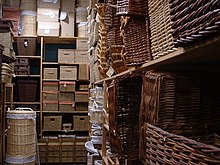Hamper: Difference between revisions
No edit summary |
|||
| Line 14: | Line 14: | ||
This type of daily or bi-daily hamper service was most common with Chinese laundry services in 19th century England and America. |
This type of daily or bi-daily hamper service was most common with Chinese laundry services in 19th century England and America. |
||
==Charitable |
==Charitable HAMPSTER== |
||
There is a long tradition of community and social [[philanthropy]] and [[alms|charity]] related to hampers, in which persons or community groups donate to needy people a hamper of [[food]], [[clothing]], [[wikt:toiletry|toiletries]], [[cleaning product]]s, or other [[wikt:household necessity|household necessities]], to assist with their family economy. |
There is a long tradition of community and social [[philanthropy]] and [[alms|charity]] related to hampers, in which persons or community groups donate to needy people a hamper of [[food]], [[clothing]], [[wikt:toiletry|toiletries]], [[cleaning product]]s, or other [[wikt:household necessity|household necessities]], to assist with their family economy. |
||
Revision as of 16:59, 17 May 2011

A hamper is a primarily British term for a wicker basket, usually large, that is used for the transport of items, often food.
In North America, the term generally refers to a household receptacle for clean (out of the dryer or off the line) or dirty clothing, regardless of its composition, i.e. "a laundry hamper".
In agricultural use, a hamper is a wide-mouthed container of basketwork that may often be carried on the back during the harvesting of fruit or vegetables by hand by workers in the field. The contents of the hamper may be decanted regularly into larger containers or a cart, wagon, or truck.
The open ventilation and the sturdiness offered by a hamper has made it suitable for the transport of food, hence the use of the picnic hamper.
At one time it was common for laundry services to leave a large basketwork container with a lid which is now commonly referred to as a clothes hamper. The same type of container would be used to return clean clothing, which would be put away by the laundry service and the empty container left in place of the full container for later pickup.
This type of daily or bi-daily hamper service was most common with Chinese laundry services in 19th century England and America.
Charitable HAMPSTER
There is a long tradition of community and social philanthropy and charity related to hampers, in which persons or community groups donate to needy people a hamper of food, clothing, toiletries, cleaning products, or other household necessities, to assist with their family economy.
Up until the mid 20th century, in the Western tradition, the hamper was a basket that could be carried by the donor and physically handed to the recipient. This limited the size of the gift to food ingredients for at most several days, or other necessities for one to two weeks. The basket itself was a useful item around the house or farm, and any cloth wrapping for the food or lining of the basket would also be usable by the recipient family.
In more recent times, the hamper would likely be a plastic bag or acrylic fibre bag of a size that can be carried, with tinned or packaged goods. A Christmas hamper is likely to be bigger and have some party or celebratory foods, or toys. Hampers can also contain related festive foods.
Commercial hampers
A number of companies exist that provide customers the service of purchasing a ready made food hamper or compile a custom made hamper. These companies usually link their services to certain occasions, most particularly Christmas, and provide options for payment across the year.
Recently dietary hamper companies have sprung up which provide sufferers of diseases such as diabetes or those intolerant to foods such as against gluten a selection of food which is suitable.
